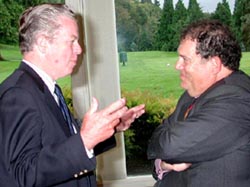|
 David Cousineau, President of Seattle Children’s Home and member of the Rotary Club of Seattle #4, was the featured speaker Friday morning. Cousineau recognized Ted Ederer of the BBRC, who he said “reshaped the United Way while serving as it’s president last year, making it a much improved and efficient organization. He also noted that Bob McNulty had urged him to buy stocks in dot.coms. Still, Cousineau was impressed by the enthusiasm and alertness of the audience! David Cousineau, President of Seattle Children’s Home and member of the Rotary Club of Seattle #4, was the featured speaker Friday morning. Cousineau recognized Ted Ederer of the BBRC, who he said “reshaped the United Way while serving as it’s president last year, making it a much improved and efficient organization. He also noted that Bob McNulty had urged him to buy stocks in dot.coms. Still, Cousineau was impressed by the enthusiasm and alertness of the audience!
He began by telling the story of a man walking along a river. He saw a child floating in the river and doing what any rescuer would do, pulled the youngster from the stream. He then ran three miles to the hospital carrying the child, who recovered. The next day, he saw two more kids in the river and he repeated his heroics. Soon, the whole community heard about this. The next day, a whole group of children are in the river and the whole town jumped in to save them.
The first man thought: ”It’s too far to carry the children to the hospital. Let’s build a hospital next to river.” A new board was created to look over the building, but something was wrong. They finally asked, “Why don’t we find out why these children are in the river?”
|

Bob Moloney (L) talks with David Cousineau after Friday’s meeting.
|
And, Seattle’s founding families established the Seattle Children’s Home 118 years ago. “The sickest, most damaged, most fragile children – 5,000 of them – are floating in the State of Washington’s river. There are 8,000 points of care for children in Washington State, but they are not connected, and rarely do they cooperate. Children bounce back and forth between islands of care. But, they go back in the river because no one will care for them long enough. And, the sickest are so hidden and sick that they are lost to the river,” Cousineau told his audience.
Who are these children? Many we don’t see, but sometimes they surface, all with unsuccessful experiences. “One young child had nine foster placements and nine different schools in one year. A girl refuses to speak because of sexual abuse, but the system doesn’t identify why. We spend a lot of money for these 5,000 kids in the 8,000 points of care. But the fact is that 30% will end up in jail, because that’s where they can count on some care.”
Cousineau said the “SCH Board went up the river to find out what was happening. We investigated how we pay for these kids’ care. It’s called ‘categorical funding,’ where a certain dollar amount is given for a certain kind of care. Kids are condemned to follow the dollar. The complexity of system hinders children.”
Seattle Children’s Home has proposed a new approach called Continuum of Care, which contains five major points:
- Front Door Assessment Center – find out all of the things going on in a kid’s life; SCH will be the guardian of this information.
- Professional tag between child and system – a person connected to the kid. An advocate for the child.
- Partners - forming partnerships with other 8,000 points of care, work together to provide a new continuum of care.
- “Close the gap” funding – money appropriated today takes care of kids’ needs up to maybe 8 on a scale of 10. The rest of this money will come from private sources. SCH will conduct a test for 5 years on the 5,000 children.
- Outcomes – what they propose will measure outcomes.
David concluded his remarks by saying, “Too many kids are in the river. WE cannot tolerate this practice anymore.” He related a final story: “If you want to see the river, see it at 2:00 in the morning. Seven years ago, I went out with the Home’s van. You see all kinds of things, but the new kids are not yet streetwise. We saw a 14-year-old girl hiding in the shadows of an alley. We tried to communicate, but she wouldn’t allow it. We left a peanut butter-and-jelly sandwich on the fire hydrant. Each day, we repeated this exercise, and on the fifth day, we were able to help her. This is the way we train animals: leave food and train them to finally respond. We have the time and talent to do it. Please help us save these kids forever.”
In answer to questions, Cousineau said the “geographic area for the project is statewide.” He was asked, How do you measure outcomes? “Formal benchmarks have been in use for years, but an informal system that asks kids if they’re getting better is what we need. We are audited 17 times a year, telling us whether our hot water is hot enough and our garbage cans clean enough. But, do we know whether our kids are getting better?”
|

Fredda Goldfarb
|
“Shelters are dead-ends,” said Cousineau. “We have 16 transitional beds to help turn kids around to adult independence. These are not just bad kids. These children are ours.”
Joining the Club for the presentation was Fredda Goldfarb, who serves as a board member for Seattle Children’s Home. For more information, visit the Seattle Children’s Home website. Find out how you can help. Thanks to Jenny Andrews for her introduction.
|